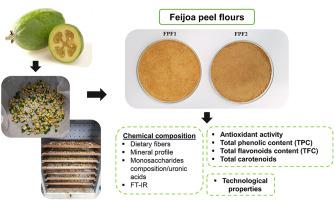Food Bioscience ( IF 4.8 ) Pub Date : 2020-10-19 , DOI: 10.1016/j.fbio.2020.100789 Júlia dos Santos Opuski de Almeida , Carolinne O. Dias , Nathalia D.A. Arriola , Bheatriz S.M. de Freitas , Alicia de Francisco , Carmen L.O. Petkowicz , Leonardo Araujo , Miguel P. Guerra , Rubens O. Nodari , Renata D.M.C. Amboni

|
Feijoa (Acca sellowiana) is an important native fruit from Southern Brazil with potential beneficial health effects, whose peels are usually discarded. The main objectives of the study were to obtain and characterize both macro and microelements to explore the technological properties of feijoa peel flours (FPF) as an alternative source of bioactive ingredients. Feijoa fruits’ peel were processed for the elaboration of two formulations of FPF, using two different sets of raw materials: only the mesocarp (FPF1) or with both the epicarp and mesocarp (FPF2). Both FPF were compared for their physicochemical content, monosaccharide composition, technological properties, bioactive compounds and in vitro antioxidant activity. Both FPF did not differ significantly in their ash, insoluble dietary fiber and phosphorus contents. Both FPF were rich in potassium and calcium. FPF2 showed higher values of acidity and pH, as well as of crude protein, total lipid, soluble dietary fiber and total dietary fiber contents than FPF1. Nevertheless, both FPF were classified as high in dietary fibers (45–48%). Predominant monosaccharides included glucose (34–43%) and xylose (33–37%), followed by uronic acid (9–12%). FPF1 showed higher water-holding capacity than FPF2, however, they did not differ in their oil-holding capacity. Moreover, FPF were rich in total phenolics, total flavonoids and carotenoids, which showed comparable antioxidant capacity in vitro. Thus, this study confirmed the feasibility of using feijoa peel by-products as flours with potential application in sustainable and functional food products.
中文翻译:

Feijoa(Acca sellowiana)果皮粉:膳食纤维和生物活性化合物的来源
Feijoa(Acca sellowiana)是来自巴西南部的重要原生水果,具有潜在的有益健康功效,通常将其果皮丢弃。这项研究的主要目的是获得和表征宏观和微量元素,以探索作为替代生物活性成分来源的非霍皮果粉(FPF)的技术特性。使用两种不同的原料,对费约果果皮进行加工,以制成两种FPF配方:仅中果皮(FPF1)或表果皮和中果皮(FPF2)。比较了两种FPF的理化含量,单糖组成,工艺特性,生物活性化合物和体外抗氧化活性。两种FPF的灰分,不溶性膳食纤维和磷含量均无显着差异。两种FPF都富含钾和钙。与FPF1相比,FPF2的酸度和pH值以及粗蛋白,总脂质,可溶性膳食纤维和总膳食纤维含量更高。尽管如此,两种FPF的膳食纤维含量都很高(45-48%)。主要的单糖包括葡萄糖(34–43%)和木糖(33–37%),其次是糖醛酸(9–12%)。FPF1具有比FPF2更高的持水量,但是它们的持油量没有差异。此外,FPF富含总酚类,总黄酮和类胡萝卜素,在体外显示出可比的抗氧化能力。因此,这项研究证实了使用美jo果皮副产品作为面粉的可行性,并将其潜在地应用在可持续和功能性食品中。











































 京公网安备 11010802027423号
京公网安备 11010802027423号